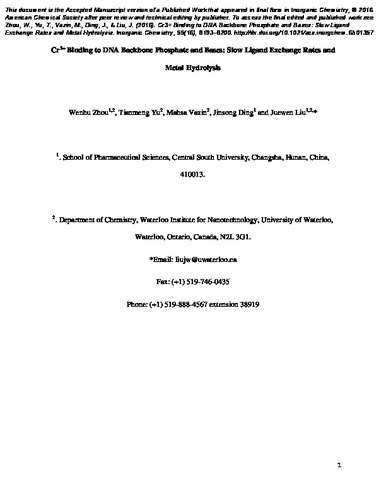| dc.contributor.author | Zhou, Wenhu | |
| dc.contributor.author | Yu, Tianmeng | |
| dc.contributor.author | Vazin, Mahsa | |
| dc.contributor.author | Ding, Jinsong | |
| dc.contributor.author | Liu, Juewen | |
| dc.date.accessioned | 2017-04-28 16:12:07 (GMT) | |
| dc.date.available | 2017-04-28 16:12:07 (GMT) | |
| dc.date.issued | 2017-06-07 | |
| dc.identifier.uri | http://dx.doi.org/10.1021/acs.inorgchem.6601357 | |
| dc.identifier.uri | http://hdl.handle.net/10012/11812 | |
| dc.description | This document is the Accepted Manuscript version of a Published Work that appeared in final form in Inorganic Chemistry, © 2016 American Chemical Society after peer review and technical editing by publisher. To access the final edited and published work see Zhou, W., Yu, T., Vazin, M., Ding, J., & Liu, J. (2016). Cr3+ Binding to DNA Backbone Phosphate and Bases: Slow Ligand Exchange Rates and Metal Hydrolysis. Inorganic Chemistry, 55(16), 8193–8200. https://doi.org/10.1021/acs.inorgchem.6601357 | en |
| dc.description.abstract | The interaction between chromium ions and DNA is of great interest in inorganic chemistry, toxicology, and analytical chemistry. Most previous studies focused on in situ reduction of Cr(VI), producing Cr3+ for DNA binding. Recently, Cr3+ was reported to activate the Cel3d DNAzyme for RNA cleavage. Herein, the Ce13d is used to study two types of Cr3+ and DNA interactions. First, Cr3+ binds to the DNA phosphate backbone weakly through reversible electrostatic interactions, which is weakened by adding competing inorganic phosphate. However, Cr3+ coordinates with DNA nucleobases forming stable cross-links that can survive denaturing gel electrophoresis condition. The binding of Cr3+ to different nucleobases was further studied in terms of binding kinetics and affinity by exploiting carboxyfluorescein-labeled DNA homopolymers. Once binding takes place, the stable Cr3+/DNA complex cannot be dissociated by EDTA, attributable to the ultraslow ligand exchange rate of Cr3+. The binding rate follows the order of G > C > T approximate to A. Finally, Cr3+ gradually loses its DNA binding ability after being stored at neutral or high pH, attributable to hydrolysis. This hydrolysis can be reversed by lowering the pH. This work provides a deeper insight into the bioinorganic chemistry Of Cr3+ coordination with DNA, clarifies some inconsistency in the previous literature, and offers practically useful information for generating reproducible results. | en |
| dc.description.sponsorship | Univ. of Waterloo; Natural Sciences and Engineering Research Council of Canada (NSERC); Foundation for Shenghua Scholar of Central South University; National Natural Science Foundation of China [21301195]; China Scholarship Council [201406370116] | en |
| dc.language.iso | en | en |
| dc.publisher | American Chemical Society | en |
| dc.subject | Cross-Link Repair | en |
| dc.subject | In-Vitro | en |
| dc.subject | Chromium(III) Complexes | en |
| dc.subject | Nucleic-Acids | en |
| dc.subject | Adducts | en |
| dc.subject | Cells | en |
| dc.subject | Mechanisms | en |
| dc.subject | DNAzyme | en |
| dc.subject | Ions | en |
| dc.subject | Mutagenicity | en |
| dc.title | Cr3+ Binding to DNA Backbone Phosphate and Bases: Slow Ligand Exchange Rates and Metal Hydrolysis | en |
| dc.type | Article | en |
| dcterms.bibliographicCitation | Zhou, W., Yu, T., Vazin, M., Ding, J., & Liu, J. (2016). Cr3+ Binding to DNA Backbone Phosphate and Bases: Slow Ligand Exchange Rates and Metal Hydrolysis. Inorganic Chemistry, 55(16), 8193–8200. https://doi.org/10.1021/acs.inorgchem.6601357 | en |
| uws.contributor.affiliation1 | Faculty of Science | en |
| uws.contributor.affiliation2 | Chemistry | en |
| uws.contributor.affiliation3 | Waterloo Institute for Nanotechnology (WIN) | en |
| uws.typeOfResource | Text | en |
| uws.peerReviewStatus | Reviewed | en |
| uws.scholarLevel | Faculty | en |

